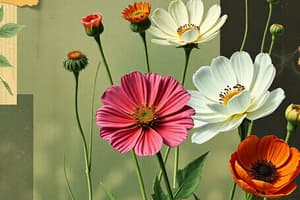Podcast
Questions and Answers
What is the main function of a flower in a plant?
What is the main function of a flower in a plant?
- To attract insects for pollination
- To provide structural support to the plant
- To produce fruit
- To ensure that pollination and seed formation are successful (correct)
Which type of plants produce flowers and fruit?
Which type of plants produce flowers and fruit?
- Gymnosperms
- Fungi
- Mosses
- Angiosperms (correct)
What is the term for the scientific study of plants?
What is the term for the scientific study of plants?
- Botany (correct)
- Ecology
- Zoology
- Horticulture
What is the correct order of the whorls in a flower, from outer to innermost?
What is the correct order of the whorls in a flower, from outer to innermost?
What type of flower has all four whorls present, including sepals, petals, and both male and female reproductive structures?
What type of flower has all four whorls present, including sepals, petals, and both male and female reproductive structures?
What is the main function of the calyx whorl in a flower?
What is the main function of the calyx whorl in a flower?
Which of the following plants typically have incomplete flowers?
Which of the following plants typically have incomplete flowers?
What is the term for the collective name of the calyx and corolla?
What is the term for the collective name of the calyx and corolla?
What is the process called when pollen is transferred from a flower on one plant to a flower on a different plant?
What is the process called when pollen is transferred from a flower on one plant to a flower on a different plant?
Which whorl of a flower consists of one or more carpels and is collectively called the pistil?
Which whorl of a flower consists of one or more carpels and is collectively called the pistil?
What is the primary function of the stigma in a flower?
What is the primary function of the stigma in a flower?
What is the collective term for the male structures of a flower?
What is the collective term for the male structures of a flower?
What is the purpose of the filament in a stamen?
What is the purpose of the filament in a stamen?
What happens when a pollen grain lands on the stigma?
What happens when a pollen grain lands on the stigma?
What is the function of the ovary in a flower?
What is the function of the ovary in a flower?
Study Notes
What is a Flower?
- Flowers are modified leaves attached to the stem of a plant, containing complex reproductive organs and specialized cells.
- They belong to the largest, most diverse group of plants on Earth, the angiosperms, which produce fruit.
- The flower of a plant serves a reproductive role to ensure pollination and seed formation are successful.
The Study of Flowers
- The scientific study of plants is called botany, which involves studying structures, functions, evolutionary relationships, growth, change, reproduction, and other aspects of plants.
- Understanding the anatomy of a flower is a specialty within botany.
Basic Structure of a Flower
- The basic flower structure includes four circular layers of specialized tissues called whorls: calyx, corolla, androecium, and gynoecium.
- The calyx consists of sepals, the corolla consists of petals, the androecium consists of male reproductive structures, and the gynoecium consists of female reproductive structures.
Complete vs. Incomplete Flowers
- Complete flowers have all four whorls present: sepals, petals, and both male and female reproductive structures.
- Incomplete flowers are missing one of the four whorls, such as corn and most grasses, which have no petals (corolla whorl) and sometimes no sepals (calyx whorl).
Whorls
- Whorls are specialized layers that make up the structure of a flower, each with a specific reproductive function.
- The four whorls are: calyx (protects the flower bud), corolla (attracts pollinators), androecium (produces pollen), and gynoecium (produces ova and provides a place for seed development).
Male and Female Parts of a Flower
- The male androecium whorl consists of one or more stamens, producing pollen (male sex cell).
- The female gynoecium whorl consists of one or more carpels, producing ova (female sex cell) and providing a place for seed development.
Pollination
- Pollination occurs when pollen is transferred onto the stigma, moving toward the ovule.
- Successful pollination can produce offspring.
- Flowers can be pollinated by wind, insects, birds, bats, water, etc.
- Self-pollination occurs when pollen from a flower pollinates a flower on the same plant.
- Cross-pollination occurs when pollen from one plant pollinates a flower on a different plant.
Studying That Suits You
Use AI to generate personalized quizzes and flashcards to suit your learning preferences.
Description
Explore the complex reproductive organs and specialized cells of flowers, and learn about the scientific study of plants, botany.



